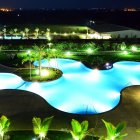Related articles
-
 Here's What to Buy in Singapore and Why You Should Expect to Go on a Shopping Spree on This Island Nation!
Here's What to Buy in Singapore and Why You Should Expect to Go on a Shopping Spree on This Island Nation!
-
 Confused About What to Buy from Dubai? Here is a Complete Shopping Guide to Help You Out (2019)
Confused About What to Buy from Dubai? Here is a Complete Shopping Guide to Help You Out (2019)
-
 दुबई में शॉपिंग करने को बहुत कुछ है, परन्तु क्या खरीदें और क्या नहीं वह भी बिना जेब खाली किये: आइये देखिये दुबई में १० खरीदने लायक सामान, अपने लिए और भेंट करने (२०१९)
दुबई में शॉपिंग करने को बहुत कुछ है, परन्तु क्या खरीदें और क्या नहीं वह भी बिना जेब खाली किये: आइये देखिये दुबई में १० खरीदने लायक सामान, अपने लिए और भेंट करने (२०१९)
Interesting Facts about Lisbon
Located in the South Central region of Portugal, Lisbon is the capital and largest city of this European country. It is a city of colonialist history, lively culture, good music, fascinating street art, mesmerising sea views and majestic architecture seen in monasteries, churches and palaces. Whether you'd like to admire the art and architecture, indulge your senses in the scenic beauty and gorgeous sunsets, or explore and shop around the city, this place has plenty in store for everyone! Let's find out more about the city's history, geographical location and its global importance.
Historical Importance
Destructive earthquakes, tsunamis, European plague or fires, Lisbon has seen it all and has always emerged stronger than before. Lisbon's history tells a lot about the various critical stages it has been through before it boomed as a major center of the vast Portuguese Empire thanks largely due to Vasco da Gama finding a sea route to India. Explorers from Lisbon also discovered gold in Brazil. Because of its great explorations and discoveries, trade in gold, spices, silks and jewels, rose significantly and the city flourished, making Lisbon a major commercial hub. The rich history of Lisbon can be better understood by visiting the city's museums and palaces.
Know its Geographical Location
Also known as the city of oceans, Lisbon is located at the entry of the Tagus River, where the river meets the Atlantic Ocean. The Tagus River is the longest river on the Iberian Peninsula and is 13 km long.
The city has a warm Mediterranean climate with an average annual temperature of 17.4 °C. The coldest month is the month of January and the warmest month is August. The winters have an average maximum daytime temperature of 14°C, whereas the temperature can reach up to 28°C in summers. Annual rainfall is from October to April.
Alpha-level Global City
The city is famously known as an alpha-level global city and is recognized as such by the Globalization and World Cities (GaWC) Study Group. This is because of its global importance in a wide range of fields from finance, media, to art and commerce. Over recent years, Lisbon has increasingly become a popular place to visit, attracting around 3 million people to live in the main city. Lisbon's mix of traditional architecture and contemporary culture makes exploring it worthwhile.
How to Reach Lisbon and Get Around?
Lisbon is accessible to many major cities across the world through flights from Humberto Delgado Airport, which is located within the city. There are two main railway stations, Santa Apolónia and Gare do Oriente. All the major cities in Portugal have direct access to Lisbon through buses and trains. Lisbon has a very clean, quick and efficient public transport network- metro, tram and good bus facilities in and around Lisbon. The best time of year to visit Lisbon is in the late spring (May-June) and the peak season is between June and August.
Explore the Many Facets of Lisbon
Lisbon is home to world's greatest explorers, like Vasco da Gama, Magellan and Prince Henry the Navigator. The picturesque landscape, a place of vintage trams and world heritage monuments, this place is an ideal city for exploring the mesmerising peace and historical mysteries. Lisbon is ideal for a short city break or a longer romantic stay, with surroundings offering an incredible variety of tourist attractions. With multiple facets of Lisbon and so many attractive places around the city, it becomes difficult to decide which all places to visit during a short vacation. We have curated a list of 10 best places to visit in Lisbon, just for you!
Architecture and Art Attractions
Architecture and Art attractions are an integral part of Lisbon's rich culture and heritage. Churches, museums, palaces and monuments, each has a unique style of construction and they must be visited by everyone who visits the city!
Belém Tower
Officially known as the Tower of Saint Vincent, Belem tower is a fortification in Lisbon, located in the middle of the Tagus river. The Belem Tower was built in the Portuguese Manueline style by sculptor Francisco de Arruda between 1514 and 1520. Because of its exceptional architecture and historical significance it has been considered as one of the UNESCO’s World Heritage monuments. It was included in the registry of the Seven Wonders of Portugal on 7th July 2007.
About 30 metres in height, situated on the northern bank of the astounding Tagus River, the Belem Tower is between the dock of Bom Sucesso and Pedrouços. A tram, either tram 15 or tram 127, from downtown area's Figueira Square till Jeronimo's Monastery will get you to the Belem Tower. Opening hours of the tower are from May to September from 10 AM to 6:30 PM.
The National Museum of Ancient Art
The National Museum of Ancient Art is also known as Museu Nacional de Arte Antiga in Portugese. With over 40,000 items, the museum has one of the largest art collections in the world. This includes sculpture, textiles, prints and paintings, decorative arts from the Middle Ages to the early 19th century.
Paintings from Europe, Asia, Africa, and the Americas are displayed in the museum. The most notable masterpieces by Hieronymus Bosch, Albrecht Dürer and Giambattista Tiepolo are also included. Founded in 1884, the museum displays the collections of the Portuguese Royal Family and the National Academy of Fine Arts. The museum also has a magnificent garden, with a restaurant, over the River Tagus. Holders of a Lisbon Card can enter for free at the National Museum of Ancient Art of Lisbon.
Regal Gardens at the Palace of the Marquises of Fronteira
Portuguese National Monument, officially known as Palácio dos Marqueses de Fronteira is located in Portugal Palace of the Marquises in Lisbon. Built-in 1671, the palace is the private residence of the Marquesses of Fronteira.
The palace is located near the Monsanto Forest Park. Some of the rooms, the library and the garden are open to public visits. The palace garden, an area of 5.5 hectares, is decorated with Portuguese tiles with the art of mythological figures. Located to next to another magnificent and attractive Tile Museum, the palace has a stunning Battle Room and the Dining Room.
Museu Nacional do Azulejo - Madre De Deus Convent (Tile Museum)
Founded in 1509 by Queen D. Leonor and originally constructed in the Manueline style, Museu Nacional do Azulejo is one of the major national museums. Also famously known as the Tile Museum, the collections are from the 15th century till the present day. The museum's collection is one of the largest ceramics collection in the world.
The Nossa Senhora da Vida (Our Lady of Life), dating from 1580 is the most fascinating thing to see in the museum. The museum also offers a sight into the development of tile-making, where visitors can enjoy learning and admiring a lot. It is the only museum in Portugal dedicated to decorative tiles. The tile mosaics are also found in Lisbon's underground metro stations.
Nature, Sightings and Outdoors in Lisbon District
Whether its scenic views inside the city or in and around the city in the Lisbon district, if you wish to witness some of the best sightings of Lisbon then you should certainly visit these recommended places!
Sintara
Known for its palaces, ancient castles and mesmerising scenery, Sintra is a city, located on the Portuguese Riviera, 25 km from Lisbon. Its picturesque beauty and historic palaces and castles makes Sintra an important tourism destination.
Sintra is famous for its gardens and nature parks. Over the years, Sintra has been ranked as one of the wealthiest municipalities in Portugal and also as one of the best places to live in the country. The town of Sintra is on top of Sintra Mountains, extending to the Atlantic Ocean. Due to its micro-climate because of Sintra mountains, the Sintra - Cascais Nature Park has rich biological diversity.
Cascais
Cascais, a municipality in the Lisbon District of Portugal, on the Portuguese Riviera, is an important tourist destination. The word "Cascais" has been derived from cascal meaning "mountain of shells", signifying the huge amount of marine molluscs harvested from the coast. Cascais has been dependent on fishing, maritime commerce and agriculture.
Cascais is situated between the lush, attractive Sintra mountains and the huge stretch of the Atlantic Ocean. The city is primarily known for its beaches, having 17 beautiful beaches. Praia da Rainha which is also known as the Queen's Beach is a beach in the centre of Cascais. Guincho Beach is famous for surfing, windsurfing, and kitesurfing and also attracts a lot of sunbathers. Cascais has fascinating castle ruins, an art museum and an ocean museum. The Estoril Casino in Cascais is one of the largest in Europe. Known for its urban and sophisticated style, with world-class hotels and vibrant nightlife, yet the major historic monuments, Cascais has been a popular tourist destination and is easily accessible by public transport from Lisbon city.
Cristo Rei National Sanctuary
Located at the other side of the Tagus river, the Cristo Rei statue, an inspiration from Rio de Janeiro’s Cristo Redeemer, gives the most panoramic view of Lisbon’s skyline. Known as an important pilgrimage destination, it was inaugurated in 1959. The statue proper and the pedestal height totals up to 110 meters. Cristo Rei is one of Lisbon’s most iconic monuments and is open every day. Taking a short ferry ride from Cais do Sodré train station and metro station, one can reach the destination.
Lisbon Oceanarium
Lisbon Oceanarium is the 2nd largest in Europe and is one of the most impressive ones in the world, housing over 450 species of marine life. The main highlights of the main aquarium are the fish moon, giant devil or manta and 5 species of sharks. 2 types of jellyfish: Pacific Nettle and Spotted Australian Jellyfish also are found in the Oceanarium. In addition to the main aquarium, there are also other smaller aquariums, based on different climatic conditions - North Atlantic rocky coast, the Tropical Indian coral reefs, the Temperate Pacific Kelp forests and the Antarctic coastal line.
If you would like to see fishes of many types of colours and sizes, be it eels, octopuses, sea horses, starfish, sea snails, crabs, or if you'd like to see birds, penguins, seagulls, then this place is a must-visit place for you. The most convenient public transportation to reach this place is by taking a metro.
Explore, Shop and Eat
If you really wish to explore, shop and eat a lot, then you are at the perfect place. Lisbon has plenty in store for you to make you happy and contended to your heart's desires.
LX Factory
Located under the 25 de Abril Bridge in a redeveloped 19th century industrial site, a trendy shopping and dining area is the LX Factory. If you wish to explore more of food, fun and art, then this place is just for you!
The textile warehouses and printing factories of previous decades, have been turned into design offices, artists' studios and hipster stores. A must-see for book lovers, food and shopping and a hippy trend of the Portuguese, this place is covered with beautiful wall art and is one of the coolest places of the city. LX Factory is close to Belem and is accessible by trams and buses.
Time Out Market
Time Out Market - a grand space of 26 restaurants, 8 bars and a dozen shops, you will get the best food of Lisbon here! Starting from steak, hamburger, nigiri, pizzas, cod, sushi all at one place, the Time Out Market is the most recommended place to visit if you are an absolute foodie or even if you are not!
What’s better, the place comes along with best live performances and awesome music, attracting a huge number of visitors all day and night. The place also houses the city's best vendors and tastes - all together under one roof.
Praca De Comercio
The grandest of Lisbon’s plazas - The Praça do Comércio, opens out on the Targus Estuary. Constructed in 1755 after the great earthquake of Lisbon, the plaza has emerged to be a great commercial and major transport hub.It is surrounded on three sides by distractive yellow Pombaline architecture.
The Praça do Comércio from the Arco da Rua Augusta viewing platform is open every day from 9 AM to 7 PM, giving fantastic views over the plaza to the tourists. Arco da Rua Augusta viewpoint, the Lisbon Story Centre museum, fine restaurants and awesome cafes are some of the best places to visit in the Praca do Comercio.
Bonus Suggestions: Two Must-Do Activities to do in Lisbon
Visiting a new place has so much in store, in terms of adventure, fun and exploration. We have two more bonus suggestions for you to do in Lisbon!
Go for a Hop-On Hop-off Bus and Tram Tour
Famous for its historic rattling trams, one of the must do activities in Lisbon is to hop on to the tram 28, which is the most famous tram route in Lisbon.The trams date from the 1930s, and they serve as an integral part of the public transport network. The 28 route is completely unsuitable for modern trams, since it has many tight turns and steep gradients. A ride along the 28 tram route gives you the best tour of Lisbon.
Go on a Mesmerising Sunset Cruise
Appreciate the view along the Tagus river and feel the beauty of the Lisbon's palaces, museums, monuments, gardens, etc, as you cruise along the river. The beautiful sunset of Lisbon skyline in the calm waters of the river is a must watch scene, that you should certainly not miss out on.
Related articles
-
 10 Best Restaurants in Bandra: from Fine Dining to Hipster Cafes and Budget Eats, These are the Places You Absolutely Need to Eat At in 2019!
10 Best Restaurants in Bandra: from Fine Dining to Hipster Cafes and Budget Eats, These are the Places You Absolutely Need to Eat At in 2019!
-
 If You’re Thinking for an Outer Trip with Your Loved One the Pearl City First Comes to Mind! 10 Best Resorts in Hyderabad That Provides the Best Luxurious and Heavenly Feeling for Stay (2020)
If You’re Thinking for an Outer Trip with Your Loved One the Pearl City First Comes to Mind! 10 Best Resorts in Hyderabad That Provides the Best Luxurious and Heavenly Feeling for Stay (2020)
-
 Planning to Travel Around India This Monsoon? Here are the Best Places to Visit in August in India (2019)
Planning to Travel Around India This Monsoon? Here are the Best Places to Visit in August in India (2019)
-
 Itching to Travel the World? Here's Our Guide to the Top 10 Best Places to Visit in the World (2019)!
Itching to Travel the World? Here's Our Guide to the Top 10 Best Places to Visit in the World (2019)!
-
 Step Out from Your Comfort Zone, the World is Waiting to Be Explored! Here are the Best Tourist Places in the World that You Won't Believe You Didn't Visit Before!
Step Out from Your Comfort Zone, the World is Waiting to Be Explored! Here are the Best Tourist Places in the World that You Won't Believe You Didn't Visit Before!
Breathtaking Lisbon
As you have noticed the mesmerising pictures from Lisbon, it is indeed an amazing place to travel to. The best way to make the most out of a trip to Lisbon is to have an itinerary prepared beforehand to know which places you want to visit. You can accordingly decide on which days you want to visit these places and have an efficient travel plan. Happy travelling!